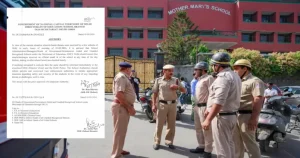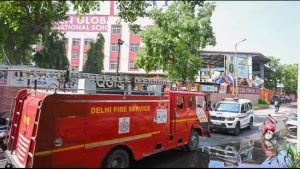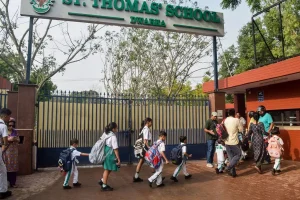New Delhi – The national capital witnessed unprecedented chaos as Delhi schools bomb threat incidents continued for the fourth straight day, affecting 45 schools and three colleges across the city. This systematic campaign of intimidation has created widespread panic among educational institutions, forcing authorities to implement comprehensive security protocols and evacuation procedures on Friday morning.
The latest wave of threats arrived via mass email overnight, discovered by staff members when they opened their institutional communications on Friday morning. The coordinated nature of these threats suggests a calculated attempt to disrupt Delhi’s educational system and create sustained psychological pressure on students, parents, and educational administrators.
Email Analysis and Disturbing Content


The threatening communication that triggered the latest Delhi schools bomb threat response was sent from roadkillmentalhospital@atomicmail.io at 10:53 PM on Thursday. The email, titled “Roadkill via SV Info,” contained explicit threats about explosive devices planted within school premises, specifically mentioning trinitrotoluene hidden in black plastic bags throughout various classrooms.
Beyond the direct threats, the message contained deeply disturbing content including suicide references and accusations against mental health professionals. The sender wrote disturbing remarks about hating their life and planning suicide after news coverage, while criticizing psychiatrists and psychologists for allegedly failing to provide adequate care to vulnerable individuals.
Immediate Security Response

Upon discovery of the Delhi schools bomb threat emails, educational institutions immediately contacted local authorities, triggering comprehensive emergency response protocols. Delhi Police deployed bomb disposal squads, local police units, and fire department personnel to conduct thorough search operations across all affected facilities.
Also Read: Delhi Imphal Indigo Flight: Emergency Return to IGI Airport After Technical Snag
Several prestigious educational institutions found themselves among the targets, including Delhi International Public School, Prudence Group of Schools, The Indian School, DPS RK Puram, and DPS Vasant Vihar. The wide range of affected institutions indicates the systematic nature of this intimidation campaign.
Evacuation Procedures and Student Safety


School administrators implemented immediate evacuation protocols upon receiving the Delhi schools bomb threat communications. Students were either sent home early or relocated to safe areas such as playgrounds while security teams conducted comprehensive searches of all potentially affected areas.
Parents were promptly notified about the security situation, with most schools maintaining clear communication channels to provide regular updates throughout the search operations. The coordinated response demonstrated the preparedness of educational institutions to handle such emergency situations effectively.
Investigation Challenges and Technical Difficulties
Authorities investigating the Delhi schools bomb threat incidents face significant technical challenges in tracing the perpetrators. The use of anonymous email services like atomicmail.io complicates identification efforts, as these platforms often operate outside standard cooperation frameworks with Indian law enforcement agencies.
Police officials identified four primary methods typically used by anonymous threat senders. The first involves mainstream providers like Google, which generally cooperate with Indian authorities. The second utilizes lesser-known services requiring formal requests through Mutual Legal Assistance Treaties, potentially taking up to two years for information retrieval.
Historical Context and Pattern Recognition
The current Delhi schools bomb threat crisis bears striking similarity to incidents from May 2024, when nearly 300 schools received similar threatening communications. That previous campaign expanded beyond educational institutions to include hospitals and museums, suggesting a broader pattern of systematic intimidation targeting public facilities.
The recurring nature of these incidents indicates either persistent individual perpetrators or coordinated efforts designed to create sustained psychological pressure on Delhi’s institutional infrastructure. The timing and systematic approach suggest careful planning rather than random acts of mischief.
School Administration Response


Educational leaders responding to the Delhi schools bomb threat situation emphasized the importance of maintaining calm while ensuring student safety. RN Jindal, chairman of The Sovereign School in Rohini, reported discovering the threat at 7:24 AM and immediately implementing evacuation procedures, with normal operations resuming after thorough security clearance.
Dipti Vohra, principal of DPS Vasant Kunj, demonstrated proactive security management by alerting authorities upon discovering threats at 12:30 AM, enabling security checks before student arrival and minimizing disruption to educational activities.
Week-Long Campaign of Intimidation
The Friday incident marked the culmination of a sustained Delhi schools bomb threat campaign spanning four consecutive days. Wednesday saw at least seven schools targeted, Tuesday affected two educational institutions, and Monday impacted three city schools, establishing a clear pattern of escalating intimidation.
This systematic approach suggests sophisticated planning and potential coordination among perpetrators, raising concerns about the broader implications for educational security in the national capital region.
Cybersecurity and Digital Forensics
Investigators analyzing the Delhi schools bomb threat communications are employing advanced digital forensics techniques to identify perpetrators despite technical obstacles. The use of proxy servers, VPNs, and dark web resources by threat creators significantly complicates traditional tracking methods.
Ongoing Security Measures


Educational authorities have implemented enhanced security protocols in response to the persistent Delhi schools bomb threat incidents. These measures include improved email monitoring systems, faster communication channels with law enforcement, and refined evacuation procedures designed to minimize disruption while ensuring comprehensive safety coverage.
The sustained nature of these threats has prompted discussions about long-term security infrastructure improvements and enhanced coordination between educational institutions and law enforcement agencies to better address future incidents.

